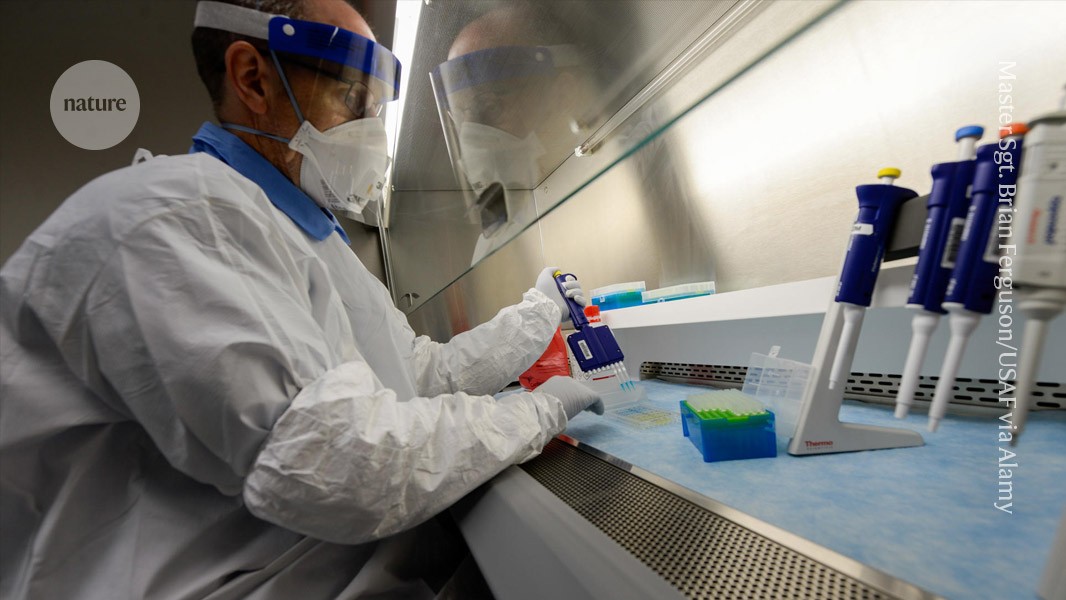Trump freezes ‘gain of function’ pathogen research ― threatening all US virology, critics say Critics say low-risk science could be affected too

An executive order suspends the use of federal funds for certain experiments on pathogens with pandemic potential

A US executive order has suspended federal funding for gain-of-function experiments, which are carried out in biosafety laboratories.Credit: Master Sgt. Brian Ferguson/USAF via Alamy
US President Donald Trump has issued an executive order suspending all federal funding for a type of virology research that his administration considers dangerous. But some scientists say the order is so broad that low-risk research will also be affected.
The funding suspension will be in place for the next four months, in which time the government says it will revise an incoming policy on how federal funding agencies and institutions oversee ‘gain of function’ experiments on pathogens that have the potential to spark a pandemic. That policy, which was years in the making and set to broaden oversight of such experiments, was due to come into effect this week.
The executive order, signed on 5 May, defines dangerous gain-of-function research as studies on infectious pathogens or toxins that have the potential to make them more deadly or transmissible. That includes work that gives pathogens the ability to evade vaccines, therapeutic agents and detection attempts, among other things.
“This is what I was expecting — an executive order banning gain-of-function research but defined in such a way that it bans all virology research,” says Gigi Gronvall, a biosecurity specialist at Johns Hopkins University in Baltimore, Maryland.
Modifying pathogens such as viruses inside a secure laboratory facility can help researchers to understand the risks the pathogens pose to society and develop vaccines and drugs against them. The work sometimes involves making pathogens more dangerous or transmissible in people. Some worry about the risk of pathogens accidentally escaping from a laboratory or being weaponized.
Researchers are often unable to predict whether their changes will make a virus more pathogenic or transmissible in people, so they might now have to avoid doing such work altogether, says Gronvall.
Sam Wilson, a molecular virologist at the University of Cambridge, UK, worries that even low-risk studies that could benefit public health will now fall under the US government’s definition of dangerous gain-of-function research.
Institutions that violate the terms of the order could be banned from receiving federal funding for up to five years. This financial penalty will make them reluctant to support infectious-disease research more broadly and “fearful of routine experiments”, says Wilson.
But some researchers have welcomed the executive order, which could result in even stricter rules around risky research.
The technology available today means that gain-of-function experiments have the potential to spark the next pandemic, says Raina MacIntyre, an infectious-diseases epidemiologist at the University of New South Wales in Sydney, Australia. “This executive order is a welcome new direction in mitigating that risk.”
The order comes at a time when many researchers in the field are already facing the prospect of huge budget cuts and grant cancellations.
COVID origin
The executive order also bans federal funding for dangerous gain-of-function research in China, Iran and other “countries of concern”. And it halts funding for life-sciences research that could pose a threat to public health in countries that do not have adequate oversight of this work. All recipients of federal grants in the life sciences will need to comply with the order, including confirming that they do not collaborate with foreign countries on relevant research.
“It is implicitly clear where the executive order is coming from: the COVID-origins debate,” says Filippa Lentzos, a biosecurity researcher at King’s College London.
A fact sheet published by the White House about the executive order specifically states that the measures are designed to reduce the possibility of lab-related incidents emerging from gain-of-function research, “like that conducted on bat coronaviruses in China by the EcoHealth Alliance and Wuhan Institute of Virology”. It notes that Trump supports the theory that the COVID-19 pandemic originated from the institute in Wuhan.
Enjoying our latest content?
Login or create an account to continue
- Access the most recent journalism from Nature's award-winning team
- Explore the latest features & opinion covering groundbreaking research
or
Sign in or create an accountdoi: https://doi.org/10.1038/d41586-025-01411-6
This story originally appeared on: Nature - Author:Smriti Mallapaty

















